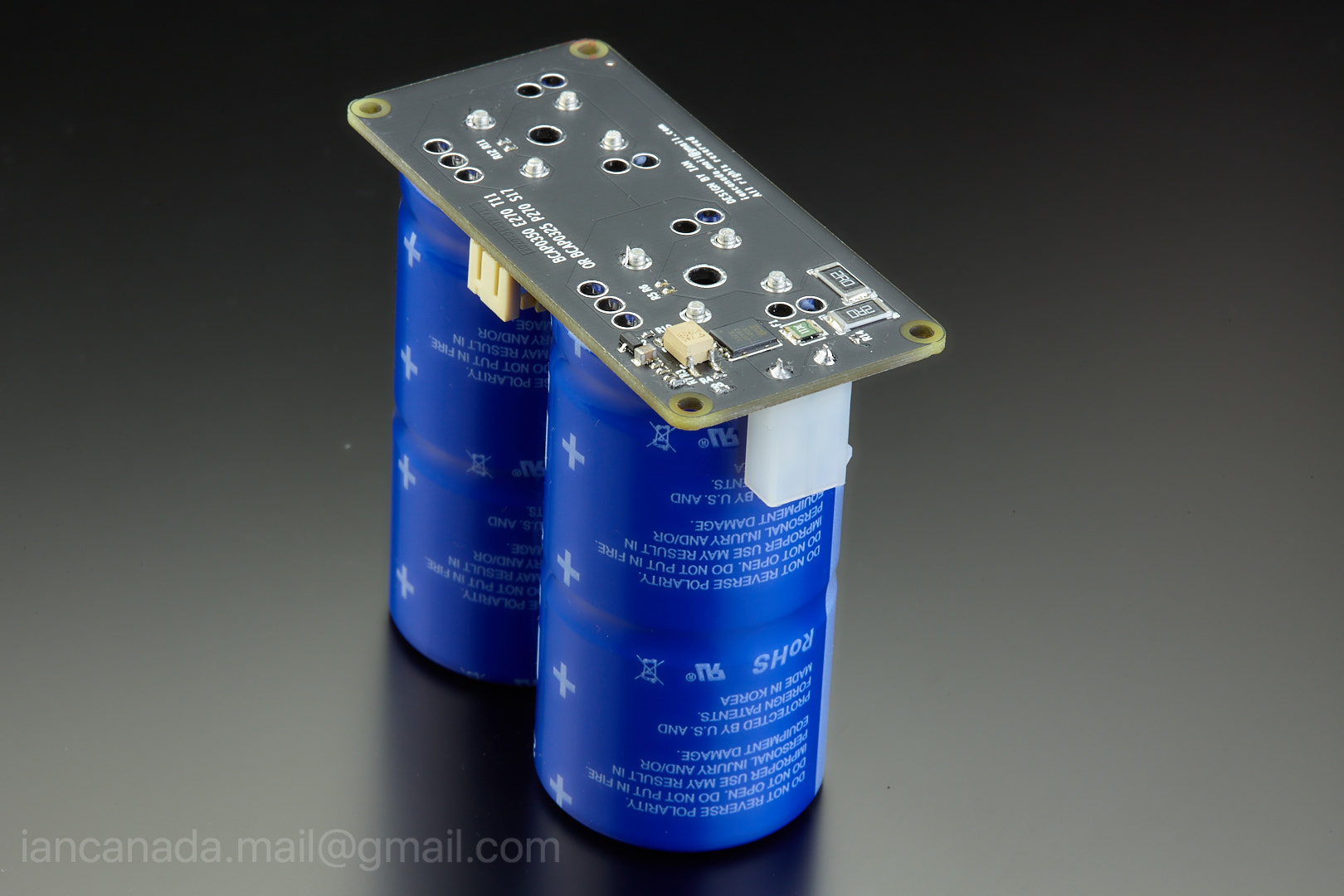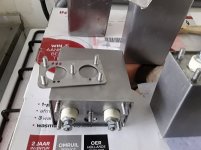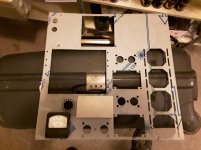Would it be possible to program lifepo4 power supply 5V power to be always on? Maybe with some firmware upgrade?
There is no need. By default, 5V power is enabled.
Good morning,ConditionerPi fits perfectly with Pi 4, Pi 3. As well as Pi 2.
Ian
Ian, what exactly Coditioner Pi can do? Does it work on 5v rail only or does it support the 3.3v as well?
Cheers, Ernst
Hello,
So far i didnt get any answers from Ian about using his power supply in my situation BUT from what i read so far i know that the conditioner PI is used to make the performance of the 5 volt supply close or equal to the 3,3 volt supply.
To improve the 3,3 volt you need to add a pair of 2,7 volt supercaps in series.
Maybe Ian needs to update the manual to answer more questions like the ones from the not so technically gifted.
Greetings, Ed
P.s i can make a stainless steel plate like the one in the attachment to check if everything fits before using red copper in about 30 minutes. Figuring out the position and dimensions of the holes takes much longer. Other people can develop circuits like Ian does. Not many people can do both.
So far i didnt get any answers from Ian about using his power supply in my situation BUT from what i read so far i know that the conditioner PI is used to make the performance of the 5 volt supply close or equal to the 3,3 volt supply.
To improve the 3,3 volt you need to add a pair of 2,7 volt supercaps in series.
Maybe Ian needs to update the manual to answer more questions like the ones from the not so technically gifted.
Greetings, Ed
P.s i can make a stainless steel plate like the one in the attachment to check if everything fits before using red copper in about 30 minutes. Figuring out the position and dimensions of the holes takes much longer. Other people can develop circuits like Ian does. Not many people can do both.
Attachments
@Slazi, see post #428 of this thread for your solution.
I couldn't find an answer from there. Is that #number right?
@hobo, I assume he meant so the pi can be left on always even during recharge of the batteries. To save sd card corruption.
Something like that. If Arduino is always on I can control power with remote control. Sd card corruption isn’t a problem if you have a great card. At least with Moode it isn’t. I had some serious problems before but they’re all gone after I bought Samsung evo card.
ConditionerPi fits perfectly with Pi 4, Pi 3. As well as Pi 2.

ConditionerPi_PiIV1 by Ian, on Flickr

ConditionerPi_PiIV2 by Ian, on Flickr
Ian
Hi Ian, when it will be possible to buy it in your GB?
@mcluxun,
See my comments and linked posts in post 1242 of this thread:
IanCanada's Latest RPi GB Goodies Impressions... and your tweaks, mods and hints...
My comments in the Katana thread compared Ian's earlier UCPi fed from at least a couple different supplies. It does matter AND the modified 5V Jameco is better to my ears (and some others) than the hallowed iFi in other applications.
BTW, a stock Jameco 5V Linear regulated wall wart is not a bad source AND at $11 USD a bargain. I likely summarized my mods in that post... if not, PM me for details.
Greg
See my comments and linked posts in post 1242 of this thread:
IanCanada's Latest RPi GB Goodies Impressions... and your tweaks, mods and hints...
My comments in the Katana thread compared Ian's earlier UCPi fed from at least a couple different supplies. It does matter AND the modified 5V Jameco is better to my ears (and some others) than the hallowed iFi in other applications.
BTW, a stock Jameco 5V Linear regulated wall wart is not a bad source AND at $11 USD a bargain. I likely summarized my mods in that post... if not, PM me for details.
Greg
Last edited:
@mcluxun,
See my comments and linked posts in post 1242 of this thread:
IanCanada's Latest RPi GB Goodies Impressions... and your tweaks, mods and hints...
My comments in the Katana thread compared Ian's earlier UCPi fed from at least a couple different supplies. It does matter AND the modified 5V Jameco is better to my ears (and some others) than the hallowed iFi in other applications.
BTW, a stock Jameco 5V Linear regulated wall wart is not a bad source AND at $11 USD a bargain. I likely summarized my mods in that post... if not, PM me for details.
Greg
I think my main confusion is about the "conditioning" part.
When fully charged, the UcConditioner is disconnected from its charger. So ideally, it's agnostic to the source. Right?
Actually no. Ian's UcConditioner is intended to add a UC pair in parallel to an existing 5v supply, such as the non-isolated 5V rail of his LiFePO4 supply.
So the 5V supply quality still matters.
This is needed because as large as 350F seems, it is only a small fraction of the capacity of the LiFePO4 cells used in that supply.
For example, a 350F UC pair will drop to 4V in about 10 minutes powering a USBBridge Signature with no charging supply.
Greg in Mississippi
So the 5V supply quality still matters.
This is needed because as large as 350F seems, it is only a small fraction of the capacity of the LiFePO4 cells used in that supply.
For example, a 350F UC pair will drop to 4V in about 10 minutes powering a USBBridge Signature with no charging supply.
Greg in Mississippi
Last edited:
UcHybrid
UcHybrid is a small size high current board that turns existing 3.3V LifePO4 battery cell into a ultra capacitor hybrid power supply.
It would be very easy to install. Just need to parallel it directly with the LifePO4 battery cell as I mentioned before.
It has built-in auto pre-charge circuit which can charge ultra capacitors automatically without needing any pre-charge in before. Passive balancers are also included.
Have to use high power soldering iron (60W or higher) to solder the pins of ultra capacitors to the UcHybrid. Both ultra capacitors and UcHybrid are high current components. Lower power iron doesn't work to solder them.
I'll design an adapter board very soon to make the UcHybrid to be integrated with LifePO4 MKIII (or possible MKII) seamlessly.

UcHybird1 by Ian, on Flickr

UcHybrid2 by Ian, on Flickr
Ian
UcHybrid is a small size high current board that turns existing 3.3V LifePO4 battery cell into a ultra capacitor hybrid power supply.
It would be very easy to install. Just need to parallel it directly with the LifePO4 battery cell as I mentioned before.
It has built-in auto pre-charge circuit which can charge ultra capacitors automatically without needing any pre-charge in before. Passive balancers are also included.
Have to use high power soldering iron (60W or higher) to solder the pins of ultra capacitors to the UcHybrid. Both ultra capacitors and UcHybrid are high current components. Lower power iron doesn't work to solder them.
I'll design an adapter board very soon to make the UcHybrid to be integrated with LifePO4 MKIII (or possible MKII) seamlessly.

UcHybird1 by Ian, on Flickr

UcHybrid2 by Ian, on Flickr
Ian
I'll design an adapter board very soon to make the UcHybrid to be integrated with LifePO4 MKIII (or possible MKII) seamlessly.
Ian
That would be great Ian. I have 4 x MKII supplies and would add the UcHybrid to all of them.
Hi Ian,
I’ll take 6, or more!
But I have the battery boards mk1. Can it be used on these? Maybe with some modification?
You can use the UcHybird on LifePO4 MKI without problem, only thing would be the mounting holes of the adapter board.
Ian
- Home
- Amplifiers
- Power Supplies
- Develop ultra capacitor power supply and LiFePO4 battery power supply


